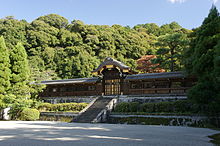|
Sennyū-ji Sennyū-ji (泉涌寺),[1] formerly written as Sen-yū-ji (仙遊寺),[2] is a Shingon Buddhist temple and head of the Sennyū-ji sect in Higashiyama-ku in Kyoto, Japan.[3] For centuries, Sennyū-ji has been a mausoleum for noble families and members of the Imperial House of Japan. Located within the temple grounds are the official tombs of Emperor Shijō[4] and many of the emperors who came after him.[2] HistorySennyū-ji was founded in the early Heian period.[2] According to one tradition, it was founded as Senyū-ji (仙遊寺) in 855 at the former mountain villa of Fujiwara no Otsugu.[5] According to another tradition, this temple was a reconstruction of an earlier temple, Hōrin-ji (法輪寺), which had been founded by Kōbō-Daishi in the Tenchō era (824–834).[3] The major buildings in Sennyū-ji were reconstructed and enlarged in the early 13th century by the monk Tsukinowa Shunjō.[5] The temple was enlarged by Priest Shunjo in 1218, and the large temple buildings were built in the contemporary Chinese style of the Song dynasty.[6] Priest Shunjo traveled to China during the Song dynasty to study Buddhism.[6]   Tsukinowa no misasagi Go-Momozono is also enshrined in Tsukinowa no misasagi along with his immediate Imperial predecessors since Emperor Go-Mizunoo -- Meishō, Go-Kōmyō, Go-Sai, Reigen, Higashiyama, Nakamikado, Sakuramachi, Momozono and Go-Sakuramachi.[8] Nochi no Tsukinowa no Higashiyama no misasagi ArtSennyū-ji's large nehan-zu painting depicts Buddha on his death bed. This massive image (8 meters x 16 meters) is the largest in Japan. The image at nearby Tōfuku-ji is the second largest of its kind in Japan, measuring 7 meters x 14 meters. Both images are only rarely displayed, most recently in 2003 for three days only.[9] See also
Notes
References
External linksWikimedia Commons has media related to Sennyuji.
|